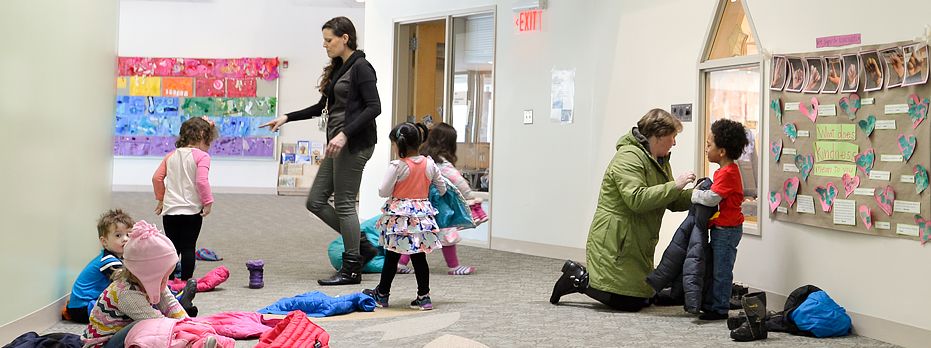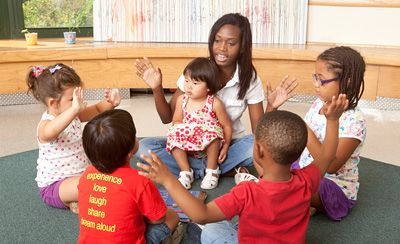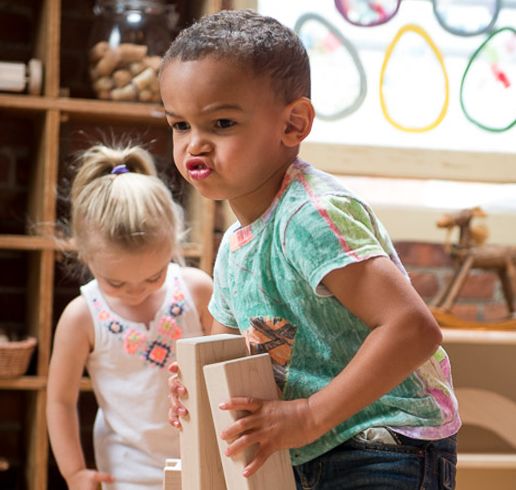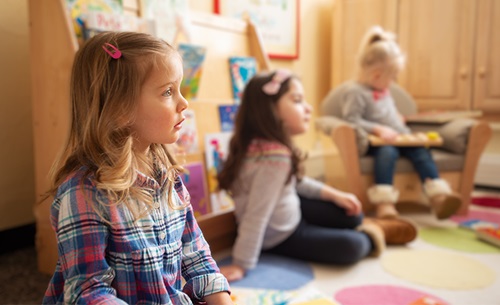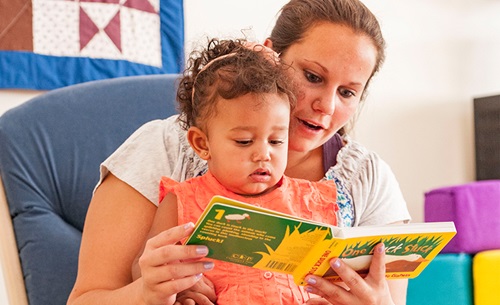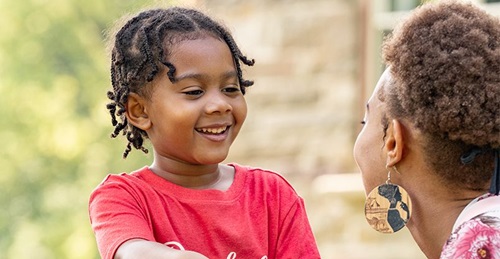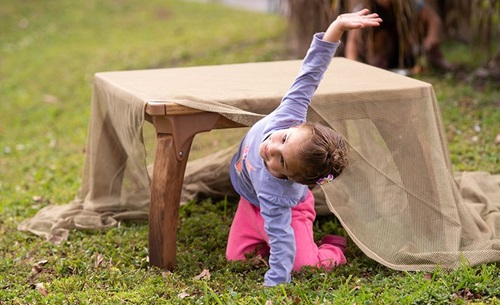Teachable Transitions
Turning Chances for Chaos into Opportunities for Learning
| September 2017No matter how you structure your day, transitions are an inevitable part of working with young children. There is always somewhere to get to next, another activity to begin, or an activity to clean up. According to some experts, these transitions tend to be a waste of time—not to mention a chance for chaos to erupt! And why wouldn’t they be?
In my site visits I’ve witnessed students struggling to be quiet while in a line—two tasks that are unnatural for young children. I’ve witnessed teachers struggling to keep children quiet and in line, using everything from raised voices to threats and bribes. But these aren’t great options because they simply don’t work with young children. The result? Frustration for both you and the kids—and an accumulation of wasted time!
But it doesn’t have to be like that. When handled in imaginative and developmentally appropriate ways—and planned, as other parts of the program are planned—transitions won’t be accompanied by chaos. After all, why fight to get the kids to move up a flight of stairs quietly when you can challenge them to pretend to be mountain climbers or weightless astronauts? Or, if that still results in too much noise, you can guide the children in a game of Follow the Leader, tiptoeing up the stairs.
Of course, making transitions chaos-free isn’t the only reason for planning them. One benefit of planning transitions is to create another opportunity for learning. Children learn to bring satisfactory closure to activities through successful transitioning. It teaches them to move easily into and out of group situations and practice following directions. These dynamics naturally entail cooperation and consideration, which are important social-emotional skills. Transitions can also be linked to curriculum content, adding continuity to your day and the repetition necessary for young children to “cement” the information acquired.
Additionally, transitions offer opportunities for problem solving, creativity, and self-expression. We can’t ever have too much of those; they’re among the skills we can be certain kids will need in this rapidly-changing world.
Transition Tools
Transitions usually require moving from one place to another. Because movement and music are natural partners they are perfect instruments for transition times. Children love movement and music which helps turn transitions into pleasurable experiences, even something to look forward to.
Movement activities, songs, and fingerplays provide focus for the children during transitions, hold the attention of waiting kids, and are easily tied to curriculum content. For example, if you’ve been studying animals, you can invite the children to move like some of the quietest ones: cats, turtles, or rabbits. If you’ve been studying the weather, you can ask them to transition as though they were clouds or a gentle breeze. Moreover, transitions present chances for further experience with movement and music—two subjects today’s teachers often have trouble finding time for.
Here are some general tips for keeping transitions tranquil and teachable:
- Remain calm and collected. If you appear “unhinged” during transitions, children will become unhinged, too. On the other hand, if you move slowly and speak softly they will respond in kind.
- Make any necessary preparations in advance. If children are transitioning to lunch, for example, they shouldn’t have to sit at the table waiting; the meal should be ready as children are concluding their prior activity. By the same token, if the transition is going to involve a prop, or maybe a fingerplay, have it ready beforehand.
- If the transition involves taking turns, such as those relating to toileting or donning outerwear, be sure the same children aren’t always chosen to go first. For example, one day you can assign brown-eyed children to go to the coatroom first. The next day all children wearing blue can go first, while children born in January lead on the following day. Young children aren’t great at waiting turns, but when experience tells them they’re going to get one, they will learn to wait.
- When you’re using fingerplays for transitions you’ll first want to demonstrate the actions while speaking or singing the words yourself. You can then repeat the process, encouraging the children to perform only the actions. On the final repetition, the children can choose to do one or the other, or both.
- When you’re using songs for transitions and you want the children to sing along, repeat the songs as often as necessary, assuring the children that you don’t expect them to sing along until they feel comfortable doing so. Often, young children won’t sing a song until it has become as familiar to them as an old friend.
Suggested Activities
Here are some specific ideas for some of the most common transitions occurring during the day, beginning with arrival.
We all like to be welcomed because it makes us feel special. You can make the children in your program feel special—and get the day started right—by providing a warm welcome for each and every arriving child.
Especially warming is the sound of one’s own name, which children love to hear. But simply saying, “Good morning, (Sarah)” may not be enough to generate enthusiasm and make the child feel glad to be there. Instead, as children arrive, meet them at the door and use a simple welcoming song like the following, sung to the tune of “Happy Birthday”:
Good morning to you,
Good morning to you,
Good morning, dear (Jose),
Good morning to you!
To transition into the rest of the day, it’s always a good idea to talk with the children about what to expect that day and then perform a relevant song or movement activity. If you’re focusing on a theme, you can relate it to the song or activity. For instance, if the theme is transportation, you might sing “Wheels on the Bus.” You can then transition into the next part of the day by moving like any one of the many modes of transportation.
Another possibility for transitioning the children from where they’ve gathered to another part of the classroom is to invite them to move in one of the following ways, making sure to ask them only to perform skills within their capabilities:
- jumping (two feet)
- hopping (one foot)
- marching
- walking
- galloping
- tiptoeing
You can ensure that cleanup is a pleasant task for young children by making it an agreeable, as well as a necessary, routine. Although experts vary in their suggestions regarding the length of notice to be given prior to cleanup time, they agree that it’s important to give children warning of forthcoming shifts in activity. Whatever amount you determine is appropriate, establish a signal, such as a flick of the lights, to indicate that it’s time to begin wrapping up. A chant can be a signal that warning time has elapsed and the actual cleanup must begin. For example:
It’s time to clean up.
It’s time to clean up.
It’s time to clean up right now!
Once cleanup starts, a number of possibilities can make it both quick and fun. Music is certainly valuable. You might choose to play a favorite recording and challenge the children to finish before the song ends. Any lively song is fine if it’s one with which the children are familiar so they can anticipate the ending.
Imagination can also make cleanup fun. Children love to pretend so you can ask them to imagine they’re vacuum cleaners, elves, garbage trucks, or giant cranes. They might also pretend to be construction workers, homemakers, or custodians!
Why transition to snack or lunchtime in the same way you’d make any other transition, when instead you can provide opportunities for children to consider the senses as they relate to food, the work involved in food preparation, and the amazing array of food available to us?
One possibility is to invite the children to show you how they would transition if they were:
- soup sloshing in a bowl.
- a sandwich.
- an egg.
- a piece of celery, or a carrot stick.
- an orange.
- Jell-O wiggling.
- the smell of food wafting through the air.
Transitions to outside the classroom can be especially chaotic. You’ll want to give the children a reason to manage themselves. A song can make leaving the room fun! The following is sung to the tune of “The Farmer in the Dell”:
We’re going out the door.
We’re going out the door.
Hi-ho, outside we go.
We’re going out the door.
We’re walking down the hall.
We’re walking down the hall.
Hi-ho, outside we go.
We’re walking down the hall.
Naturally, there will be times when you’ll need to transition as quietly as possible. At those times, imagery that brings quiet to mind is needed. Possibilities include moving like:- one of the quiet animals mentioned earlier.
- a librarian.
- a whisper.
- a butterfly.
- a inchworm.
As you can see, it takes only a little bit of imagination and intentionality to create tranquil, teachable transitions. Yes, it may take a bit of time and planning in the beginning; but in the long run it will be worth it for both the children and you.

